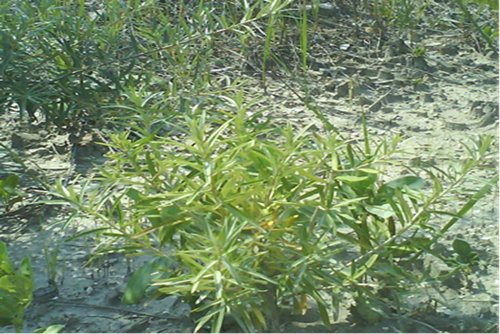
The optimal way of biological cleaning of oil-contaminated soils
Abstract
The results of development of way of biological cleaning of soils from oil pollution on the example of Boryslav are shown. The prospects of tree species for the remediation of oil-contaminated soils are studied. The best results of cleaning oil contaminated soils with the application of Hippophae rhamnoides L. plants were obtained. We have shown that the Hippophae rhamnoides L. plants successfully adapt to the extreme conditions of oil contaminated soils, improve its physical and chemical properties, reduce the amount of oil. Purification degree of soils from oil pollution reaches 92.7%. The plants of these species decrease of toxicity of oil-contaminated soil and improve its microbiological properties too. Hippophae rhamnoides L. plants are promising agents for remediation of oil-contaminated soils, attractive from both environmental and economic point of view.
Full Text:
PDFReferences
Song X. M., Hase A., Laukkarinen A., Salonen S., Hakala E. The effect of oxygen enriched burning in hazardous-Waste incineration. Chemosphere. 1992; 24: 249-259.
Nito S., Akimoto Y., Imagawa T., Inouye Y. Comparative study of on formations of polychlorinateddibenzo-p-dioxin, polychlorinated dibenzofuran and related compounds by pyrolysis. Chemosphere. 1997; 35: 1717-1727.
Eckenfelder W.W.J., Norris R.D. Applicability of Biological Process for Treatment of Soils. In: Emerging Technologies in Hazardous Waste Management, Tedder, D.W. and F.G. Pohland (Eds.). American Chemical Society, Washington, D.C., 1993: 138-158.
Okoh, A.I. Biodegradation alternative in the clean up of petroleum hydrocarbon pollutants. A review. Biotechnology and Molecular Biology. 2006; 1(2):38–50.
Shimp J.F., Tracy J.C., Davis L.C., Lee E., Huang W., Erickson L.E., and Schnoor J.L. Beneficial effects of plants in the remediation of soil and groundwater contaminated with organic materials. Crit. Rev. Environ. Sci. Technol.1993; 23: 41–77.
Stomp A. M., Han K. H., Gordon M. P. Genetic improvement of tree species for remediation of hazardous wastes. In Vitro Cell. Dev. Biol. 1993; 29: 227–232.
Schnoor J.L., Licht L.A., McCutcheon S.C., Wolfe N.L., Carreira L.H., Phytoremediation of organic and nutrient contaminants, Environ. Sci. Technol. 1995; 29: 318–323.
Cunningham S.D., Berti W.R. Remediation of contaminated soil with green plants: an overview. In Vitro Cell. Dev. Biol. 1993; 29: 207–212.
Suominen L., Jussila M., Makclainen K. Evaluation of the Galega-Rhizobium galegae system for the bioremediation of oil contaminated soil. Environmental Pollution. 2000; 107: 239–244.
Banks M.K, Schwab P., Liu B., Kulakow P., Smith J.S., Kim, R. The effect of plants on the degradation and toxicity of petroleum contaminants in soil: A field assessment. Adv Biochem Eng Biotech. 2003; 78: 75-96.
Dzhura N., Romaniuk O., Honsor Ia., Tsvilyniuk O., Terek O. Using plants for restoration of the oil-cut soils. Ecology and Noosferology. 2006; 17(1-2): 55-60.
Radwan S.S., Dashti N., El-Nemr I.M. Enhancing the growth of Vicia faba plants by microbial inoculatin to improve their phytoremediation potential for oil desert areas. Intl. J. PhytoremediationÑŽ 2005; (1): 19-32.
Eman A. Diab. Phytoremediation of oil contaminated Desert soil using the Rhizosphere effects, Department of plant Ecology and ranges, Environmental Pollution Research unit; DRC. Egypt Global Journal of Environmental Research. 2008; 2 (2): 66-73.
Patent 16345 UA, MPK A01B 79/00, A01B 79/02, A01C 21/00. Method to purify oil-polluted soils / Dzhura Natalia Myronivna, Terek Olha Ishtvanivna, Tsilyniuk Olha Mykolaivna (Ukraine) – publ. 15.08.2006.
Patent 73287 UA, MPK Ð01Ð’ 79/02, B09C 1/00. Method for cleaning soil against oil pollution / Velychko Oksana Ivanivna, RomaniukOlha Ivanivna, Dzhura Natalia Myronivna, Terek Olha Ishtvanivna (Ukraine)-publ. 25.09.2012.
Patent 60481 UA, MPK B09C 1/00, A01B 79/02. Method for phytotreating oil-polluted soils / Dzhura Natalia Myronivna, Romaniuk Olha Ivanivna, Tsilyniuk Olha Mykolaivna, Terek Olha Ishtvanivna (Ukraine) - publ. 25.06.2011.
Zhang, Z., Zhou, Q., Peng, S. and Cai, Z. Remediation of Petroleum Contaminated Soils by Joint Action ofPharbitis nil L. and its Microbial Community. Science of the Total Environment. 2010; 408: 5600-5605.
Lu, S., Teng, Y., Wang, J. and Sun, Z. Enhancement of Pyrene Removed from Contaminated Soils by Bidens Maximowicziana. Chemosphere. 2010; 81: 645-650.
Roidaki A, Zoumpoulakis PG and Proestos C. Comparison of Extraction Methods for the Determination of Antioxidant Activity in Extracts of Hippophae Rhamnoides L. and Lippia Citriodora. The Effect of Seasonal Collection. Austin J Nutri Food Sci-2015,3(1)1057- 1064
Patent 86572 UA, MPK B09C 1/00, A01B 79/00. Method of cleaning technogenic soils contaminated by oil /Romaniuk Olha Ivanivna, Shevchyk Lesya Zenovievna, Terek Olha Ishtvanivna (Ukraine) - publ. 10.01.2014.
GOST (State Standard) 17.4.4.02-84: Nature protection. Soils. Methods for sampling
and preparation of soils for chemical, bacteriological, helmintological analysis.
Haziyev F.H. Methods of a soil enzimologiya. Moscow: Science; 1990. 189 p.
Shevchik L., Romaniuk O. Researching regularities of influence of oil on the initial growth parameters of test-objects plants. Visnyk of the Lviv University. Series Biology. 2014; 67: 129–137.
Segi J. Methods of soil microbiology. Moscow: Kolos; 1983. 109 p.
Ilyina A., Castillo Sanchez M.I., Villarreal Sanchez J.A., Ramirez Esquivel G. Isolation of soil bacteria for bioremediation of hydrocarbon contamination. Vestn. Mosk. University. Chemistry. 2003; 44: 88-91.
Chopik V.I., Dudchenko L.G., Krasnova A.N. Wild-growing useful plants of Ukraine. Kiev: N. idea Publ; 1983. 399 p.
Refbacks
- There are currently no refbacks.
